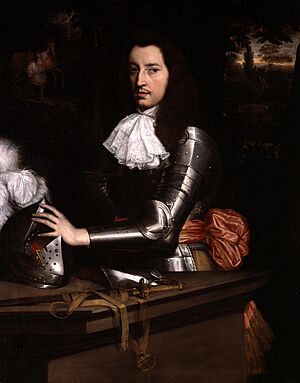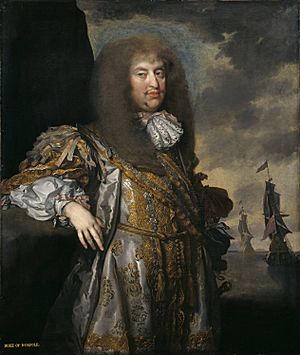Henry Howard, 6th Duke of Norfolk facts for kids
Quick facts for kids
The Duke of Norfolk
|
|
|---|---|

Portrait by John Michael Wright
|
|
| Earl Marshal | |
| In office 1672 – 13 January 1684 |
|
| Monarch | |
| Preceded by | In Commission |
| Succeeded by | The 7th Duke of Norfolk |
| Member of the House of Lords Lord Temporal |
|
| In office 13 December 1677 – 13 January 1684 Hereditary Peerage |
|
| Preceded by | The 5th Duke of Norfolk |
| Succeeded by | The 7th Duke of Norfolk |
| Personal details | |
| Born | 12 July 1628 Arundel House, London, England |
| Died | 13 January 1684 (aged 55) Arundel House, London, England |
| Resting place | Arundel Castle, Arundel, West Sussex |
| Spouses | Lady Anne Somerset Jane Bickerton |
| Children | Henry Howard, 7th Duke of Norfolk Frances de Andía-Irarrazaval, Marchioness of Valparaiso Lord Thomas Howard Lord George Howard Lord James Howard Lord Frederick Henry Howard Lady Catherine Howard Elizabeth Gordon, Duchess of Gordon Lady Philippa Howard |
| Parents | Henry Howard, 22nd Earl of Arundel Lady Elizabeth Stuart |
Henry Howard, 6th Duke of Norfolk (born July 12, 1628 – died January 13, 1684), was an important English nobleman and a member of Parliament. He was the second son of Henry Howard, the 22nd Earl of Arundel. When his older brother, Thomas Howard, the 5th Duke of Norfolk, passed away in 1677, Henry became the 6th Duke.
Life of a Duke
Henry Howard was given important titles before he became Duke. In 1669, he was made the first Baron Howard of Castle Rising. Then, in 1672, he became the first Earl of Norwich. At this time, he also helped bring back the important job of Earl Marshal of England for his family. This job was very old and important, dealing with ceremonies and coats of arms.
The King, Charles II, and the House of Lords (a part of Parliament) wanted to bring back the title of Duke of Norfolk in 1660. Since the 5th Duke was unwell and living in Italy, it was decided that Henry, his brother, should join the House of Lords in his own right.
When Henry became Duke, he announced that he had married Jane Bickerton. This caused some disagreements within his family, and he traveled abroad for a while. Despite this, he was still very influential in politics. For example, in 1673, he helped Samuel Pepys, a famous diarist, get a seat in Parliament.
In January 1678, Henry took his place in the House of Lords. However, later that year, a difficult time began called the Popish Plot. This led to a new law that stopped Catholics from being in Parliament. As a strong Roman Catholic, Henry would not take an oath that recognized the King as the head of the Church. But he encouraged other Catholic peers to take the oath if they felt they could, to help keep the House of Lords strong. For this, the Lords thanked him. He then moved to Bruges for three years, where he could practice his faith freely.
During his life, Henry Howard was also known for his generosity. He gave a large part of his library and some of his land to the Royal Society, which is a famous group for scientists. He also gave a valuable collection of ancient Greek and Roman sculptures, known as the Arundelian marbles, to Oxford University.
He returned to England later and was present at the trial of his uncle, William Howard, 1st Viscount Stafford. His uncle was accused during the Popish Plot events. Henry and most of the other Howard family members who were peers voted that his uncle was guilty. After the trial, Henry returned to Bruges for a time.
As the difficult period of accusations calmed down, he felt it was safe to come back home. A famous diarist named John Evelyn visited him in 1683 and wrote about Henry's impressive collection of artworks, including drawings by famous artists like Raphael.
Family and Children
Around 1652, Henry Howard married Lady Anne Somerset. She was the daughter of Edward Somerset, 2nd Marquess of Worcester. Henry and Anne had several children:
- Lady Elizabeth Howard, who married George Gordon, 1st Duke of Gordon.
- Henry Howard, 7th Duke of Norfolk, who became the next Duke.
- Lady Frances Howard.
- Lord Thomas Howard (1662–1689), who had children, including two future Dukes of Norfolk:
Later, Henry married his second wife, Jane Bickerton, in 1676 or 1677. They had four sons and three daughters, but their sons did not have children.
- Lord George Howard
- Lord James Howard
- Lord Frederick Henry Howard
- Lady Catherine Howard, who became a nun.
- Lady Philippa Howard
The special titles created for Henry, like Baron Howard of Castle Rising and Earl of Norwich, ended when his grandson, the 9th Duke, passed away in 1777. However, the later Dukes of Norfolk came from his brothers' families.


